Rep:Mod:Mt4618
NH3
Optimisation
NH3 |
Calculation Method: RB3LYP
Basis Set: 6-31G(d,p)
E(RB3LYP): -56.55776873 a.u.
RMS Gradient Norm: 0.00000485 a.u.
Point Group: C3V
Optimised N-H bond length: 1.02 A
Optimised H-N-H bond angle: 106o
Item Value Threshold Converged? Maximum Force 0.000004 0.000450 YES RMS Force 0.000004 0.000300 YES Maximum Displacement 0.000072 0.001800 YES RMS Displacement 0.000035 0.001200 YES
Vibration and Charges
Vibrations

| No. | Wavenumber / cm-1 | Symmetry | Intensity |
|---|---|---|---|
| 1 | 1090 | A1 | 145 |
| 2 | 1694 | E | 14 |
| 3 | 1694 | E | 14 |
| 4 | 3461 | A1 | 1 |
| 5 | 3590 | E | 0 |
| 6 | 3590 | E | 0 |
Number of modes expected from 3N-6 rule: 6
Degenerate modes: 2&3 and 5&6
Bending vibration modes: 1,2,3
Stretching vibration modes: 4,5,6
Highly symmetric mode: 4
"Umbrella" mode: 1
No. of bands expected in gaseous spectrum: 2 (4 out of 6 modes are degenerate and 3 out of 6 are ~ 0 intensity)
Charges

A negative charge is expected on the nitrogen atom as it is more electronegative than hydrogen.
N2
Optimisation
An optimised N2 molecule |
Calculation Method: RB3LYP
Basis Set: 6-31G(d,p)
E(RB3LYP): -109.52412868 a.u.
RMS Gradient Norm: 0.00000060 a.u.
Point Group: D*H
Optimised bond length: 1.11 A
Optimised bond angle: 180o
Item Value Threshold Converged? Maximum Force 0.000001 0.000450 YES RMS Force 0.000001 0.000300 YES Maximum Displacement 0.000000 0.001800 YES RMS Displacement 0.000000 0.001200 YES
Vibration and Charges
Vibrations
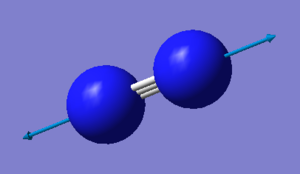
| No. | Wavenumber / cm-1 | Symmetry | Intensity |
|---|---|---|---|
| 1 | 2457 | SGG | 0 |
Number of modes expected from 3N-5 rule: 1
Number of bending vibration modes: 0
Number of stretching vibration modes: 1
No. of bands expected in gaseous spectrum: 0 (vibration does not produce any change in dipole moment)
Charges
Charge is evenly distributed across N2 as there is no difference in electronegativity.
H2
Optimisation
An optimised H2 molecule |
Calculation Method: RB3LYP
Basis Set: 6-31G(d,p)
E(RB3LYP): -1.17853936 a.u.
RMS Gradient Norm: 0.00000017 a.u.
Point Group: D*H
Optimised bond length: 0.74 A
Optimised bond angle: 180o
Item Value Threshold Converged? Maximum Force 0.000000 0.000450 YES RMS Force 0.000000 0.000300 YES Maximum Displacement 0.000000 0.001800 YES RMS Displacement 0.000001 0.001200 YES
Vibration and Charges
Vibrations
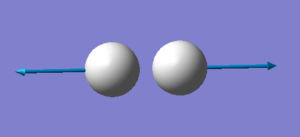
| No. | Wavenumber / cm-1 | Symmetry | Intensity |
|---|---|---|---|
| 1 | 4466 | SGG | 0 |
Number of modes expected from 3N-5 rule: 1
Number of bending vibration modes: 0
Number of stretching vibration modes: 1
No. of bands expected in gaseous spectrum: 0 (vibration does not produce any change in dipole moment)
Charges
Charge is evenly distributed across H2 as there is no difference in electronegativity.
Transition metal complex
Unique Identifier: BOWVUG [1]
N-N bond distance in complex: 1.13 A
N-N bond distance in optimised molecule: 1.11 A
The N-N bond distance in complex is greater than that in the optimised molecule because electron density is pulled away from N2 when it binds to Mo resulting in weaker N-N bonding in the complex.
Haber Process
E(NH3) = -56.55776873 a.u.
2*E(NH3) = -113.1155375 a.u.
E(N2) = -109.52412868 a.u.
E(H2) = -1.17853936 a.u.
3*E(H2) = -3.53561808 a.u.
ΔE=2*E(NH3)-[E(N2)+3*E(H2)]= -0.05579074 a.u.
ΔE=2*E(NH3)-[E(N2)+3*E(H2)]= -146.8 kJ/mol
The reaction is exothermic therefore, ammonia must be below the reactants in an energy profile diagram. So, ammonia is more stable.
HCN
Optimisation
An optimised HCN molecule |
Calculation Method: RB3LYP
Basis Set: 6-31G(d,p)
E(RB3LYP): -93.42458132 a.u.
RMS Gradient Norm: 0.00017006 a.u.
Point Group: C*V
Optimised bond length: 1.11 A
Optimised bond angle: 180o
Item Value Threshold Converged? Maximum Force 0.000370 0.000450 YES RMS Force 0.000255 0.000300 YES Maximum Displacement 0.000676 0.001800 YES RMS Displacement 0.000427 0.001200 YES
Vibration and Charges
Vibrations
| No. | Wavenumber / cm-1 | Symmetry | Intensity |
|---|---|---|---|
| 1 | 766.74 | PI | 35.2959 |
| 1 | 766.74 | PI | 35.2959 |
| 1 | 2214.74 | SG | 2.0451 |
| 1 | 3479.93 | SG | 57.3217 |
Number of modes expected from 3N-5 rule: 4
Number of bending vibration modes: 2
Number of stretching vibration modes: 2
No. of bands expected in gaseous spectrum: 3 (vibrations 1&2 degenerate)
Charges
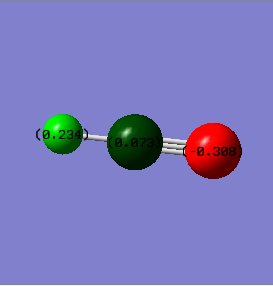
N being more electronegative than H and C, a negative charge is expected on N in HCN and positive charges are expected on H and C.
Molecular Orbitals
Molecular orbital 8

Antibonding/bonding: Antibonding
Occupancy: Unoccupied
Contributing AOs: 3px of N, 3px of C
Energy: 0.01929 a.u.
MO8 is the LUMO of HCN. Sideways antiphase overlap of 3px orbitals of N and C makes it the 1π* orbital of HCN.
Molecular Orbital 7
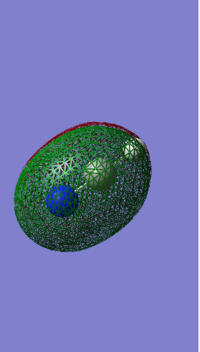
Antibonding/bonding: Bonding
Occupancy: Occupied
Contributing AOs: 2py of N, 2py of C
Energy: -0.35939 a.u.
MO7 is the HOMO of HCN. Sideways overlap of 3py orbitals of N and C makes it the 2π orbital of HCN. It is degenerate with MO6 and together with it, they contribute to the triple bond in HCN.
Molecular Orbital 6

Antibonding/bonding: Bonding
Occupancy: Occupied
Contributing AOs: 2px of N, 2px of C
Energy: -0.35939 a.u.
MO6 is the HOMO of HCN. Sideways overlap of 3px orbitals of N and C makes it the 1π orbital of HCN. It is degenerate with MO7 and together with it, they contribute to the triple bond in HCN.
Molecular Orbital 5
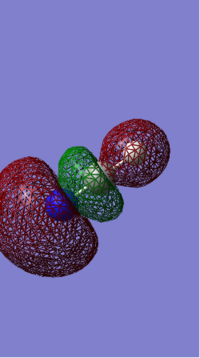
Antibonding/bonding: Antibonding
Occupancy: Occupied
Contributing AOs: 2pz of N, 3s of N, 2pz of C, 3s of N, 1s of H
Energy: -0.38064 a.u.
MO5 is the 3σ* orbital of HCN. From N, roughly 51% of electron density comes from 2pz while 45% comes from 3s. By contrast, 24% comes from 2pz and 13% from 1s in H.
Molecular Orbital 1
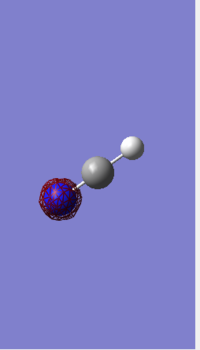
Antibonding/bonding: Bonding
Occupancy: Occupied
Contributing AOs: 1s of N, 1s of C
Energy: -0.38064 a.u.
MO1 is the lowest energy 1σ orbital of HCN. It does not participate in chemical reactions.
Variations in CN bond length in HCN(Independence)
Optimised CN bond length in HCN= 1.146 A
Experimental CN bond length = 1.156 A[Experimental Data for HCN]
The experimentally measured CN bond length differs from the optimised CN bond length as the latter is the result of an optimisation calculation.
Marking
Note: All grades and comments are provisional and subject to change until your grades are officially returned via blackboard. Please do not contact anyone about anything to do with the marking of this lab until you have received your grade from blackboard.
Wiki structure and presentation 1/1
Is your wiki page clear and easy to follow, with consistent formatting?
YES
Do you effectively use tables, figures and subheadings to communicate your work?
YES
NH3 1/1
Have you completed the calculation and given a link to the file?
YES
Have you included summary and item tables in your wiki?
YES
Have you included a 3d jmol file or an image of the finished structure?
YES
Have you included the bond lengths and angles asked for?
YES
Have you included the “display vibrations” table?
YES
Have you added a table to your wiki listing the wavenumber and intensity of each vibration?
YES
Did you do the optional extra of adding images of the vibrations?
NO
Have you included answers to the questions about vibrations and charges in the lab script?
YES
N2 and H2 0/0.5
Have you completed the calculations and included all relevant information? (summary, item table, structural information, jmol image, vibrations and charges)
YES - However, you stated bond angles for diatomic molecules. To define a bond angle a minimum of 3 atoms is needed.
Crystal structure comparison 0.5/0.5
Have you included a link to a structure from the CCDC that includes a coordinated N2 or H2 molecule?
YES
Have you compared your optimised bond distance to the crystal structure bond distance?
YES
Haber-Bosch reaction energy calculation 1/1
Have you correctly calculated the energies asked for? ΔE=2*E(NH3)-[E(N2)+3*E(H2)]
YES - The calculated energy is wrong by 0.3 kJ/mol. This is probably due to wrong rounding during your calculation.
Have you reported your answers to the correct number of decimal places?
YES
Do your energies have the correct +/- sign?
YES
Have you answered the question, Identify which is more stable the gaseous reactants or the ammonia product?
YES
Your choice of small molecule 3.5/5
Have you completed the calculation and included all relevant information?
YES
Have you added information about MOs and charges on atoms?
YES
You correctly identified the contributing AOs but gave wrong principal quantum numbers (e.g. it is more likely the the 2p orbitals contribute to the displayed MOs than 3p Aos. MO5 is a bonding orbital. A node does not mean the MO is anti-bonding. There are no nodes between C and N or N and H. Only the 1s of N is contributing to the last displayed MO. This is a non-bonding orbital rather than a bonding one. You could have explained and discussed the relative MO energies.
Independence 0/1
If you have finished everything else and have spare time in the lab you could:
Check one of your results against the literature, or
YES - However, your comparison is minimal and more important the given link is not working.
Do an extra calculation on another small molecule, or
Do some deeper analysis on your results so far
